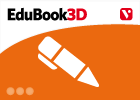Cargando...
Recursos educativos
-
Nivel educativo
-
Competencias
-
Tipología
-
Idioma
-
Tipo de medio
-
Tipo de actividad
-
Destinatarios
-
Tipo de audiencia
-
Creador
-

The nervous system
EduBook Organización
- 6030 visitas
Right now, you are reading these words and you understand them. If you see food when you are hungry, your mouth starts to water. If you burn your hand, you move it away immediately. You automatically do…
-

Check. The Mediterranean landscape
EduBook Organización
- 5541 visitas
Review what you have studied and answer the questions: What are the main characteristics of the Mediterranean climate? What is the woodland of Mediterranean climates like? What vegetation replaces…
-

Answer. From the Caliphate of Cordoba to the taifa kingdoms
EduBook Organización
- 4957 visitas
Remember what you have studied in this section and do the activities: What was the Caliphate of Cordoba? Who founded it? When and why did it disappear? Explain what the taifa kingdoms were. Which Muslim…
-

Initial evaluation 7.03 - Absolute Monarchy: The Catholic Monarchs
EduBook Organización
- 4889 visitas
Look at the map and answer the questions: Which kingdoms were there on the Iberian Peninsula at the beginning of the 15th century? When did the Catholic Monarchs unite each of these kingdoms under the…
-

Check. The first humans: The Paleolithc Age
EduBook Organización
- 4906 visitas
Review what you have studied and answer the questions: What do we mean when we say that people in the Palaeolithic Age were predators and nomads? What did people in the Palaeolithic Age use fire for?…
-

Complete. Net immigration rate
EduBook Organización
- 4717 visitas
Complete the text about net immigration with the missing words: A country has a when there are more people entering the country than leaving it. This influences the country in many ways: there is an in…
-

The natural environment
EduBook Organización
- 4634 visitas
The place where a living thing lives is called a habitat. When we study a habitat, we look at the living things (animals and plants) that live there. We also look at the non-living things around them.…
-

Zoo animals
Amanda Carrasco Docente
- 5 lo usan
- 3705 visitas
In this game you have a picture of an animal. For example, a tiger. How do you spell tiger? It's t-i-g-e-r. Can you hit t, i, g, e and r on the balloons as they go past? You must hit them in the…
-

Think. Matter and its properties
EduBook Organización
- 4380 visitas
Answer the questions: Give five examples of substances. Write the names of five objects that you can see around you; name the main substance that they are made of and list some of its properties. When…
-

Population and work
EduBook Organización
- 4316 visitas
5.1. The active and inactive population When analysing a country's development, we study the relationship between the population and work. There are two types of population: The active population.…
Te estamos redirigiendo a la ficha del libro...













